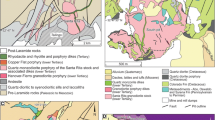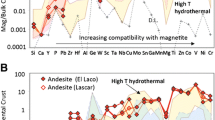Abstract
We have characterized the distribution of 25 trace elements in magnetite (Mg, Al, Si, P, Ca, Sc, Ti, V, Cr, Mn, Co, Ni, Cu, Zn, Ga, Ge, Y, Zr, Nb, Mo, Sn, Hf, Ta, W, and Pb), using laser ablation ICP-MS and electron microprobe, from a variety of magmatic and hydrothermal ore-forming environments and compared them with data from the literature. We propose a new multielement diagram, normalized to bulk continental crust, designed to emphasize the partitioning behavior of trace elements between magnetite, the melt/fluid, and co-crystallizing phases. The normalized pattern of magnetite reflects the composition of the melt/fluid, which in both magmatic and hydrothermal systems varies with temperature. Thus, it is possible to distinguish magnetite formed at different degrees of crystal fractionation in both silicate and sulfide melts. The crystallization of ilmenite or sulfide before magnetite is recorded as a marked depletion in Ti or Cu, respectively. The chemical signature of hydrothermal magnetite is distinct being depleted in elements that are relatively immobile during alteration and commonly enriched in elements that are highly incompatible into magnetite (e.g., Si and Ca). Magnetite formed from low-temperature fluids has the lowest overall abundance of trace elements due to their lower solubility. Chemical zonation of magnetite is rare but occurs in some hydrothermal deposits where laser mapping reveals oscillatory zoning, which records the changing conditions and composition of the fluid during magnetite growth. This new way of plotting all 25 trace elements on 1 diagram, normalized to bulk continental crust and elements in order of compatibility into magnetite, provides a tool to help understand the processes that control partitioning of a full suit of trace elements in magnetite and aid discrimination of magnetite formed in different environments. It has applications in both petrogenetic and provenance studies, such as in the exploration of ore deposits and in sedimentology.



Similar content being viewed by others
References
Andersen D, Lindsley D (1985) New (and final!) models for the Ti-magnetite/ilmenite geothermometer and oxygen barometer. Eos Trans AGU 66:416
Angerer T, Hagemann SG, Danyushevsky L (2012) Geochemical evolutions of the banded iron formation-hosted high-grade iron ore system in the Koolyanobbing Greenstone Belt, Western Australia. Econ Geol 107:599–644
Angerer T, Hagemann SG, Danyushevsky L (2013) High-grade iron ore at Windarling, Yilgarn Craton: a product of syn-orogenic deformation, hypogene hydrothermal alteration and supergene modification in an Archean BIF-basalt lithostratigraphy. Miner Deposita 48:697–728
Audetat A, Pettke T (2006) Evolution of a porphyry-Cu mineralized magma system at Santa Rita, New Mexico (USA). J Petrol 47:2021–2046
Baker T, Van Achterberg E, Ryan CG, Lang JR (2004) Composition and evolution of ore fluids in a magmatic-hydrothermal skarn deposit. Geol 32:117–120
Barnes S-J, Maier WD, Ashwal LD (2004) Platinum-group element distribution in the Main Zone and Upper Zone of the Bushveld Complex, South Africa. Chem Geol 208:293–317
Barnes S-J, Maier WD, Curl EA (2010) Composition of the marginal rocks and sills of the Rustenburg Layered Suite, Bushveld Complex, South Africa: implications for the formation of the platinum-group element deposits. Econ Geol 105:1491–1511
Bhattacharya HN, Chakrabort I, Ghosh KK (2007) Geochemistry of some banded iron-formations of the Archean supracrustals, Jharkhand-Orissa region, India. J Earth Syst Sci 116:245–259
Bonyadi Z, Davidson GJ, Mehrabi B, Meffre S, Ghazban F (2011) Significance of apatite REE depletion and monazite inclusions in the brecciated Se–Chahun iron oxide–apatite deposit, Bafq district, Iran: insights from paragenesis and geochemistry. Chem Geol 281:253–269
Boutroy E, Dare SAS, Beaudoin G, Barnes S-J, Lightfoot PC (2014) Magnetite composition in Ni-Cu-PGE deposits worldwide and its application to mineral exploration. J Geochem Explor doi:10.1016/j.gexplo.2014.05.010
Chiaradia M, Müntener O, Beate B (2011) Enriched basaltic andesites from mid-crustal fractional crystallization, recharge, and assimilation (Pilavo Volcano, Western Cordillera of Ecuador). J Petrol 52:1107–1141
Dare SAS, Barnes S-J, Beaudoin G (2012) Variation in trace element content of magnetite crystallized from a fractionating sulfide liquid, Sudbury, Canada: implications for provenance discrimination. Geochim Cosmochim Acta 88:27–50
Dupuis C, Beaudoin G (2011) Discriminant diagrams for iron oxide trace element fingerprinting of mineral deposit types. Miner Deposita 46:319–335
Gardeweg MC, Sparks RSJ, Matthews SJ (1998) Evolution of Lascar volcano, northern Chile. J Geol Soc 155:89–104
Gregory MJ (2006) Copper mobility in the Eastern Creek Volcanics, Mount Isa, Australia: evidence from laser ablation ICP-MS of iron-titanium oxides. Miner Deposita 41:691–711
Grigsby JD (1990) Detrital magnetite as a provenance indicator. J Sediment Res 60
Higgins MD (2005) A new interpretation of the structure of the Sept Iles Intrusive suite, Canada. Lithos 83:199–213
Jugo PJ, Wilke M, Botcharnikov RE (2010) Sulfure K-edge XANES analysis of natural and synthetic basaltic glasses: implications for S speciation and S content as function of oxygen fugacity. Geochim Cosmochim Acta 74:5926–6938
Keith JD (1997) The role of magmatic sulfides and mafic alkaline magmas in the Bingham and Tintic mining districts, Utah. J Petrol 38:1679–1690
Larocque AC, Stimac JA, Keith JD, Huminicki MAE (2000) Evidence for open-system behavior in immiscible Fe-S-O liquids in silicate magmas: implications for contributions of metals and sulfur to ore-forming fields. Can Mineral 38:1233–1250
Layton-Matthews D, Lesher CM, Burnham OM, Liwanag J, Halden NM, Hulbert L, Peck DC (2007) Magmatic Ni-Cu-platinum-group element deposits of the Thompson Nickel Belt. Mineral Deposits of Canada: A synthesis of major deposit-types, District Metallogeny, the evolution of geological provinces, and exploration methods Edited by WD Goodfellow Geological Association of Canada, Mineral Deposits Division, Special Publication 5:409–432
Lepage LD (2003) ILMAT: an Excel worksheet for ilmenite–magnetite geothermometry and geobarometry. Comput Geosci 29:673–678
Liu P-P, Zhou M-F, Chen WT, Boone M, Cnudde V (2014) Using multiphase solid inclusions to constrain the origin of the Baima Fe-Ti-(V) oxide deposit, SW China. J Petrol 55:951–976
Maier WD, Barnes S-J, Gartz V, Andrews G (2003) Pt-Pd reefs in magnetites of the Stella layered intrusion, South Africa: a world of new exploration opportunities for platinum group elements. Geology 31:885–888
Martin-Tanguay B (2012) Pétrographie et caractérisation des oxydes de Fe-Ti à Saint-Charles de Bourget (Québec), associé à la suite anorthositique du Lac-Saint-Jean. Université du Québec à Chicoutimi, pp 71
McCarthy T, Cawthorn RG (1983) The geochemistry of vanadiferous magnetite in the Bushveld complex: implications for crystallization mechanisms in layered complexes. Miner Deposita 18:505–518
Méric J (2011) Caractérisation géochimiques des magnétites de la zone critique de l’intrusion magmatique de Sept-Iles (Québec, Canada) et intégration a une base de données utilisant la signature géochimique des oxydes de fer comme outil d’exploration Université du Québec à Chicoutimi - Université Montpellier 2, pp 48
Mitsis I, Economou-Eliopoulos M (2001) Occurrence of apatite associated with magnetite in an ophiolite complex (Othrys), Greece. Am Mineral 86:1143–1150
Mitsis I, Economou-Eliopoulos M (2003) On the origin of hydroxylapatite associated with pure massive magnetite in the Othrys Ophiolite Complex, Greece. Ofioliti 28:25–32
Mollo S, Putirka K, Iezzi G, Scarlato P (2013) The control of cooling rate on titanomagnetite composition: implications for a geospeedometry model applicable to alkaline rocks from Mt. Etna volcano. Contrib Mineral Petrol 165:457–475
Nabil H (2003) Genèse des dépôts de Fe-Ti-P associés aux intrusions litées (exemples: l'intrusion mafique de Sept-Iles, au Québec; complexe de Duluth aux États-Unis). Université du Québec à Chicoutimi, pp 537
Nadeau O, Williams-Jones AE, Stix J (2010) Sulphide magma as a source of metals in arc-related magmatic hydrothermal ore fluids. Nat Geosci 3:501–505
Nadoll P, Mauk JL, Hayes TS, Koenig AE, Box SE (2012) Geochemistry of magnetite from hydrothermal ore deposits and host rocks of the Mesoproterozoic Belt Supergroup, United States. Econ Geol 107:1275–1292
Nadoll P, Angerer T, Mauk JL, French D, Walshe J (2014) The chemistry of hydrothermal magnetite: a review. Ore Geol Rev 16:1–32
Namur O, Charlier B, Toplis MJ, Higgins MD, Liégeois J-P, Vander Auwera J (2010) Crystallization sequence and magma chamber processes in the ferrobasaltic Sept Iles layered intrusion, Canada. J Petrol 51:1203–1236
Néron A (2012) Caractérisation géochimiques des oxydes de Fe-Ti dans un dépôt de Fe-Ti-P associe à la suite anorthositique de Lac Saint Jean, Québec, Canada (secteur Lac à Paul) et intégration des données du secteur Lac à La Mine. Université du Québec à Chicoutimi, pp 39
Nyström J, Henríquez F (1994) Magmatic features of iron ores of the Kiruna type in Chile and Sweden: ore textures and magnetite geochemistry. Econ Geol v:89
Park J-W, Campbell IH, Ickert RB, Allen CM (2013) Chalcophile element geochemistry of the Boggy Plain zoned pluton, southeastern Australia: a S-saturated barren compositionally diverse magmatic system. Contrib Mineral Petrol 165:217–236
Pecoits E, Gingras M, Barley M, Kappler A, Posth N, Konhauser K (2009) Petrography and geochemistry of the Dales Gorge banded iron formation: paragenetic sequence, source and implications for palaeo-ocean chemistry. Precambrian Res 172:163–187
Pons JM, Franchini M, Meinert L, Recio C, Etcheverry R (2009) Iron skarns of the Vegas Peladas District, Mendoza, Argentina. Econ Geol 104:157–184
Potvin-Doucet C (2012) Distribution et comparaison d'éléments traces dans la magnétite contenue dans des granites de types I et S Sciences de la terre. Université du Québec à Chicoutimi, pp 43
Ray G, Webster I (2007) Geology and chemistry of the low Ti magnetite-bearing Heff Cu-Au skarn and its associated plutonic rocks, Heffley Lake, south-central British Columbia. Explor Min Geol 16:159–186
Razjigaeva N, Naumova V (1992) Trace element composition of detrital magnetite from coastal sediments of northwestern Japan Sea for provenance study. J Sediment Res 62:802–809
Reguir EP, Chakhmouradian AR, Halden NM, Yang P, Zaitsev AN (2008) Early magmatic and reaction-induced trends in magnetite from the carbonatites of Kerimasi, Tanzania. Can Mineral 46:879–900
Rudnick R, Gao S (2003) Composition of the continental crust. Treatise Geochem 3:1–64
Rusk B, Oliver N, Cleverley J, Blenkinsop T, Zhang D, Williams P, Habermann P (2010) Physical and chemical characteristics of the Ernest Henry iron oxide copper gold deposit, Australia: implications for IOGC genesis. In: Porter T (ed) Hydrothermal iron oxide copper-gold and related deposits: a global perspective, v 3—advances in the understanding of IOCG deposits. PGC Publishing, Adelaide, pp 201–218
Sawyer E (2010) Migmatites formed by water-fluxed partial melting of a leucogranodiorite protolith: microstructures in the residual rocks and source of the fluid. Lithos 116:273–286
Shimazaki H (1998) On the occurrence of silician magnetites. Resour Geol 48:23–29
Tegner C, Cawthorn RG, Kruger FJ (2006) Cyclicity in the Main and Upper Zones of the Bushveld Complex, South Africa: crystallization from a zoned magma sheet. J Petrol 47:2257–2279
Tollari N, Barnes S-J, Cox R, Nabil H (2008) Trace element concentrations in apatites from the Sept-Îles Intrusive Suite, Canada—implications for the genesis of nelsonites. Chem Geol 252:180–190
Toplis M, Carroll M (1995) An experimental study of the influence of oxygen fugacity on Fe-Ti oxide stability, phase relations, and mineral—melt equilibria in ferro-basaltic systems. J Petrol 36:1137–1170
Toplis MJ, Corgne A (2002) An experimental study of element partitioning between magnetite, clinopyroxene and iron-bearing silicate liquids with particular emphasis on vanadium. Contrib Mineral Petrol 144:22–37
Van Baalen MR (1993) Titanium mobility in metamorphic systems: a review. Chem Geol 110:233–249
Yang S, Wang Z, Gui Y, Li C, Cai J (2009) Heavy mineral compositions of the Changjiang (Yangtze River) sediments and their provenance-tracing implication. J Asian Earth Sci 35:56–65
Acknowledgments
This project was funded by NSERC, DIVEX, Vale, and the Canadian Research Chair in Magmatic Metallogeny. We thank S. Medhi, D. Savard, and M. Choquette for their assistance with laser ablation-ICP-MS and microprobe analyses and F. Tornos for andesite samples from Chile. Comments by E. Sawyer and D. Gaboury helped improve the paper at an early stage. We thank the Editors (A. Barth and R. Cox) and reviewers of Geology (K. Goodenough, J. Mauk, and 1 anonymous) for their useful comments which helped improve an early version of this manuscript. Thanks are also given to P. Nadoll and B. Lehmann for their reviews and editorial handling of this manuscript in Mineralium Deposita.
Author information
Authors and Affiliations
Corresponding author
Additional information
Editorial handling: B. Lehmann
Electronic supplementary material
Below is the link to the electronic supplementary material.
ESM 1
(PDF 126 kb)
Rights and permissions
About this article
Cite this article
Dare, S.A.S., Barnes, SJ., Beaudoin, G. et al. Trace elements in magnetite as petrogenetic indicators. Miner Deposita 49, 785–796 (2014). https://doi.org/10.1007/s00126-014-0529-0
Received:
Accepted:
Published:
Issue Date:
DOI: https://doi.org/10.1007/s00126-014-0529-0




